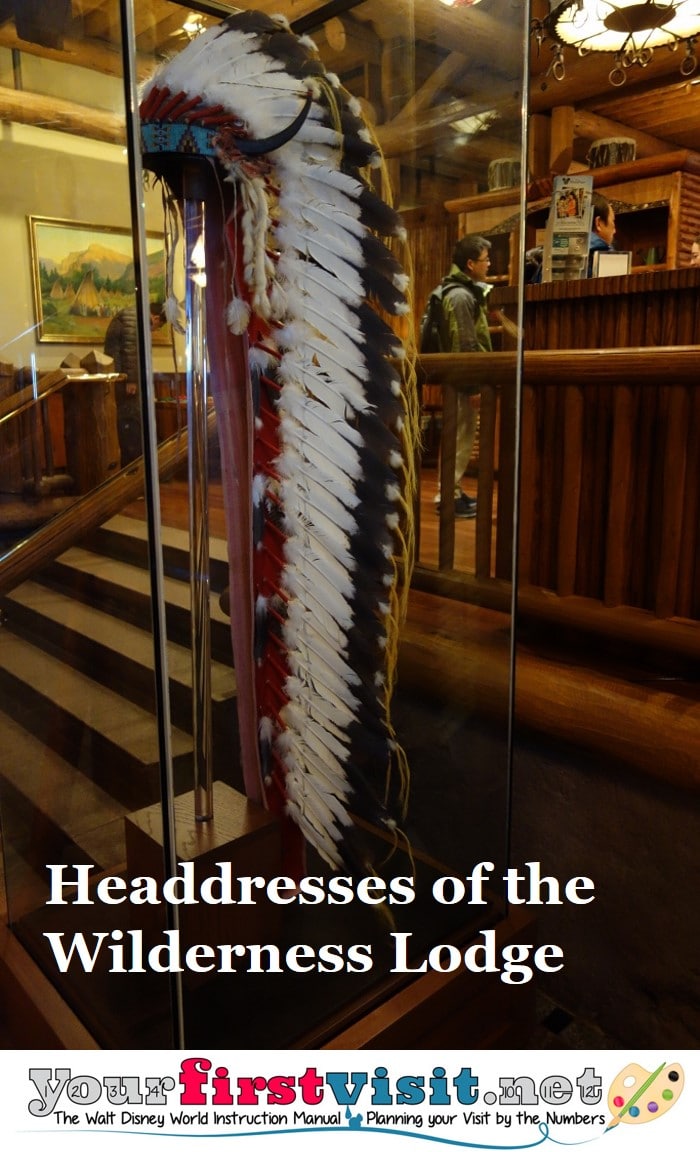A Friday Visit with Jim Korkis: Headdresses of the Wilderness Lodge
By Dave Shute
Welcome back to Fridays with Jim Korkis! Jim, the dean of Disney historians and author of Jim’s Gems in The easy Guide, writes about Walt Disney World history every Friday on yourfirstvisit.net.
HEADDRESSES OF THE WILDERNESS LODGE
By Jim Korkis
Some Native Americans believed that by wearing the feathers of the eagle, one of the most respected and revered birds, it was possible to impart the characteristics and power of the eagle to the wearer. It was usually the chief who would wear such a headdress and it was hoped it would provide wisdom and a different perspective.
At the entrance to the Whispering Canyon restaurant at Disney’s Wilderness Lodge are two headdresses on display. When the Imagineers had to re-create a headdress, they were not allowed to use eagle feathers because eagles are an endangered species, so they used turkey feathers and enhanced them.

This particular headdress was inspired by one belonging to Mato-Tope of the Mandan Tribe.
On the right hand side is a Double Trailer Eagle Feathers Headdress from around 1875. A double trailer headdress is named for the two felt trailers that hang down the back of the headdress to the ground. An elaborate headdress of this style would have been worn by the highest ranking member of the Sioux tribe.
This particular headdress was inspired by one belonging to Chief Red Cloud of the Oglala Lakota tribe of the Great Sioux Nation.
Located between two bundles of lodgepoles towards the back of the lobby is the Ermine-Tipped Raven Headdress that resembles a nineteenth century Crow warrior headdress. Inspiration for this headdress is the watercolor painting done by artist Charles Bodmer that is located just off the lobby elevator on the fourth floor. The painting was rendered in the 1830s during an expedition led by Prince Maximillian to the American West.
Just to the right of the elevators is the Feather Duster Rooster Feathers Headdress. It was used by the Crow tribe circa 1890. The red of the feathers indicates war honor.
In addition, there is an authentic display of moccasins made by the Plains Indians. Hard rawhide soles were hand sewed to a soft buckskin upper piece. Often, they would chew on the material to make it softer and more pliable. The footwear was then ornamented with dyes, quills, beads, cloth, buttons, fur and fringe and this work varied greatly among the different tribes.
Using no measuring tools or patterns, moccasins were each one-of-a-kind made to fit a specific foot of a child or adult. Intricate designs existed only the minds of the Native Americans making them and sometimes the design evolved as it was being worked on.
Another display case specifically showcases some actual beadwork for a variety of different articles. The “seed” bead, a small round opaque Venetian glass bead, became available to the Native American cultures around 1840 through the pioneers entering their territories. Because “seed” beads were partly handmade, they were somewhat irregular.
The delicacy of the bead pattern determined the size of the bead chosen. When settlers began to crowd into the Sioux country about 1860, beadwork became a major industry for the Native Americans that was highly popular until around 1900, although examples of this beautiful craft are still produced in smaller quantities today.
Settlers sometimes dictated the style of bead pattern for the garments they were willing to purchase or trade. Later visitors to the area brought imported Czechoslovakian beads, which were somewhat darker than Venetian beads and had a slightly bluish tinge.
The items in the lobby of the Wilderness Lodge are a mixture of real and re-created, but the re-creations were done by Native Americans using the same materials and methods as their ancestors. Everything in the lobby from the chandeliers to the displays is meant to honor Native American culture and its significant part in the opening of the west.
* * * * *
Thanks, Jim!
Jim has written multiple articles on this site on the Wilderness Lodge–see this and this and this and this! And come back next Friday for more from Jim Korkis!
In the meantime, check out his books, including his latest, Gremlin Trouble! The Cursed Roald Dahl Film Disney Never Made, Secret Stories of Walt Disney World: Things You Never You Never Knew, which reprints much material first written for this site, and his contributions to The easy Guide to Your Walt Disney World Visit, all published by Theme Park Press.
Follow yourfirstvisit.net on Facebook or Twitter or Pinterest!!





0 comments
Comment by typing in the form below.
Leave a Comment | Ask a Question | Note a Problem